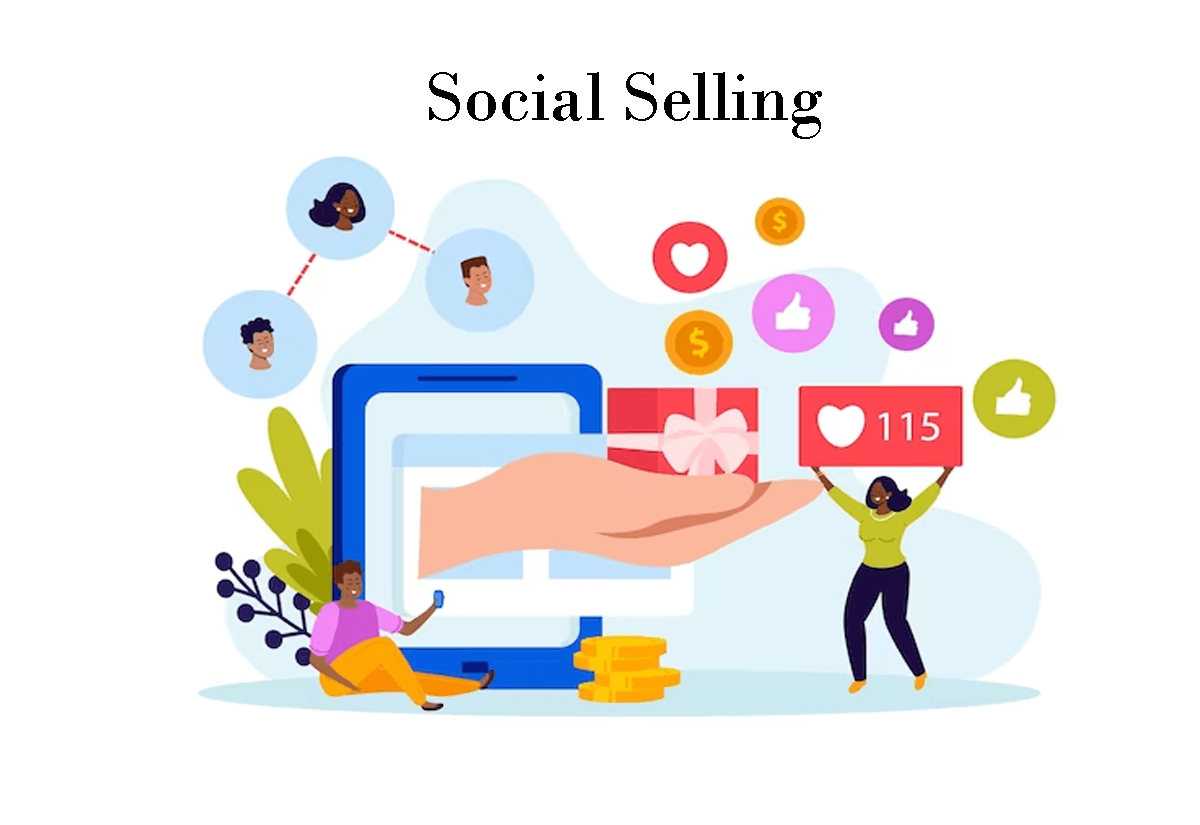What's Inside?
What is social selling and how does it work?
Social selling is the process of using social media platforms to build relationships and engage with potential customers in order to drive sales. It involves using social media channels like LinkedIn, Twitter, and Facebook to connect with prospects, share content and insights, and provide value to potential customers.
Rather than relying on traditional sales methods like cold calling and direct mail, social selling is focused on establishing trust and building long-term relationships with prospects. By leveraging the power of social media, sales professionals can engage with potential customers in a more authentic and meaningful way, which can lead to increased sales and customer loyalty over time.
Social selling typically involves a combination of tactics, including content marketing, personal branding, and relationship building. The goal is to establish yourself as a thought leader in your industry, connect with potential customers in a meaningful way, and ultimately drive sales through these relationships.
Benefits of social selling for businesses
 Social selling has several benefits for businesses, including:
Social selling has several benefits for businesses, including:
- Increased Sales: By leveraging social media, businesses can connect with potential customers and engage with them directly, which can lead to increased sales.
- Improved Customer Relationships: Social selling allows businesses to engage with customers on a personal level, building stronger relationships and increasing customer loyalty.
- Greater Brand Awareness: Social media platforms provide businesses with an opportunity to reach a wider audience and increase brand awareness through shares and likes.
- Cost-Effective: Social media platforms are free to use, making social selling a cost-effective marketing strategy.
- Insight into Customer Needs: Social selling allows businesses to gather valuable insights into their customers’ needs, preferences, and behaviors, which can inform future marketing strategies and product development.
Social selling helps businesses build relationships, increase sales, and improve their brand image.
Tips for building a successful social selling strategy
Here are some tips for building a successful social selling strategy:
- Define your target audience: Determine the ideal customer profiles that you want to reach through social selling. Understand their needs, pain points, and interests to create a targeted and personalized approach.
- Establish your social presence: Optimize your social media profiles by providing relevant information, sharing industry insights, and engaging with your followers. Establish your credibility as a thought leader in your industry.
- Create and curate valuable content: Share content that your target audience will find interesting, informative, and valuable. Create original content, curate third-party content, and share user-generated content to create a well-rounded mix.
- Engage with prospects: Use social media platforms to engage with prospects by commenting on their posts, sharing relevant content, and sending personalized messages. Focus on building relationships rather than pitching your product or service.
- Monitor and measure your efforts: Track your social selling efforts and measure the results. Analyze your engagement metrics, leads generated, and sales closed to understand what’s working and what’s not.
- Build a social selling culture: Encourage your sales team to adopt social selling practices and provide them with the necessary training and tools to succeed. Share success stories, best practices, and tips to keep them motivated and engaged.
- Stay up-to-date with trends and best practices: Social selling is an ever-evolving practice, so it’s important to stay informed about the latest trends, best practices, and tools. Attend industry events, read industry blogs, and connect with other social sellers to stay informed.
Role of social media in social selling
The role of social media in social selling is significant. Social media platforms provide a vast amount of data about potential customers, including their interests, behavior, and preferences. This data can be leveraged by sales professionals to personalize their approach, improve engagement, and build trust with prospects.
Social media platforms also offer a variety of tools and features that can be used to facilitate social selling. For example, LinkedIn provides Sales Navigator, a tool designed specifically for sales professionals to help them find leads, build relationships, and close deals. Twitter, Facebook, and Instagram all offer advertising tools that can be used to target specific audiences based on various criteria such as location, interests, and demographics.
In addition to providing data and tools, social media platforms are also a great way to establish thought leadership and build brand awareness. By regularly sharing content that is relevant and valuable to their target audience, sales professionals can position themselves and their company as experts in their industry and build trust with potential customers.
Social media plays a critical role in social selling by providing a platform for sales professionals to connect with potential customers, establish thought leadership, and build relationships.
How to identify and target potential customers through social selling
 To identify and target potential customers through social selling, here are some tips:
To identify and target potential customers through social selling, here are some tips:
- Conduct research: Research your target audience and identify their interests, pain points, and needs. Use social media listening tools to track their online behavior and understand what type of content they engage with.
- Build relationships: Social selling is about building relationships and establishing trust with your audience. Engage with your prospects on social media by commenting on their posts, sharing their content, and answering their questions.
- Provide value: Offer valuable content and insights that address your prospects’ pain points. Share blog posts, whitepapers, videos, and other content that showcases your expertise and helps them solve their problems.
- Use social media advertising: Social media advertising can help you target specific demographics, interests, and behaviors. Use paid advertising to reach new audiences and promote your content.
- Monitor metrics: Use social media analytics to track your performance and adjust your strategy accordingly. Monitor metrics such as engagement, reach, and conversions to measure the effectiveness of your social selling efforts.
- Leverage social selling tools: Use social selling tools such as LinkedIn Sales Navigator, Hootsuite, and HubSpot to streamline your social selling process and identify new opportunities. These tools can help you find and engage with prospects more efficiently, and provide insights to improve your social selling strategy.
Best practices for engaging with customers through social selling
Engaging with customers through social selling can be an effective way to build relationships, establish trust, and ultimately increase sales. Here are some best practices for engaging with customers through social selling:
- Be authentic: People can tell when you’re not being genuine, so be yourself and let your personality shine through. This can help you build trust with potential customers.
- Listen to your customers: Social media provides a wealth of information about your customers’ wants, needs, and pain points. Use this information to tailor your approach and offer solutions that meet their needs.
- Provide value: Share content that is relevant and helpful to your customers, even if it doesn’t directly promote your product or service. This can help establish your expertise and build trust.
- Be responsive: Respond to comments and messages in a timely manner, even if it’s just to acknowledge the comment. This shows that you’re paying attention and that you care about your customers.
- Use social media to build relationships: Social selling is about building relationships, so take the time to engage with your customers on a personal level. This can help establish trust and loyalty over time.
- Be persistent: Social selling can take time and effort, so don’t give up if you don’t see immediate results. Keep engaging with your customers and providing value, and you’ll likely see results over time.
Measuring the success of social selling efforts
Measuring the success of social selling efforts is an important aspect of any social selling strategy. Here are some key metrics that businesses can use to track the effectiveness of their social selling efforts:
- Engagement: One of the most important metrics for measuring social selling success is engagement. This includes likes, comments, shares, and other forms of interaction on social media platforms.
- Lead generation: Social selling can be a powerful tool for generating new leads. By tracking the number of leads generated through social selling efforts, businesses can get a sense of how effective their strategy is.
- Sales: Ultimately, the goal of social selling is to generate more sales. By tracking sales that result from social selling efforts, businesses can determine whether their strategy is effective or not.
- Reach: The reach of social selling efforts refers to the number of people who are exposed to your content. By tracking reach, businesses can get a sense of how well their social selling efforts are resonating with their target audience.
- Conversion rates: Conversion rates refer to the percentage of leads that actually turn into customers. By tracking conversion rates, businesses can determine how effective their social selling efforts are at driving revenue.
- Customer feedback: Social selling is all about building relationships with customers. By tracking customer feedback, businesses can get a sense of how well they’re doing at building those relationships and adjust their strategy accordingly.
The key to measuring the success of social selling efforts is to identify the right metrics and track them consistently over time. By doing so, businesses can optimize their social selling strategy and achieve better results.
Integrating social selling into your overall sales and marketing strategy
 Integrating social selling into your overall sales and marketing strategy involves aligning your social selling efforts with your broader business goals, sales strategy, and marketing activities. Here are some tips:
Integrating social selling into your overall sales and marketing strategy involves aligning your social selling efforts with your broader business goals, sales strategy, and marketing activities. Here are some tips:
- Define your social selling objectives: Before you start implementing social selling, you should define clear objectives that align with your business goals. These objectives can be related to lead generation, customer engagement, brand awareness, or any other relevant metrics.
- Identify your target audience: Identify the target audience for your social selling efforts, including the decision-makers and influencers you want to reach.
- Develop a social selling plan: Develop a plan that outlines your social selling tactics and how you will engage with your target audience. This plan should include your social media channels, messaging, content, and metrics for tracking success.
- Collaborate with marketing: Collaborate with your marketing team to ensure that your social selling efforts are aligned with your broader marketing strategy. This includes coordinating messaging, content, and branding across all channels.
- Train your sales team: Provide training and support for your sales team to help them understand how to effectively use social media for selling. This includes training on best practices, social media platforms, and how to measure success.
- Measure and refine: Continuously measure and analyze your social selling efforts to identify areas for improvement. Use data to refine your approach and optimize your strategy over time.
Integrating social selling into your overall sales and marketing strategy can help you build stronger relationships with your customers, increase your brand awareness, and drive revenue growth.
Impact of social selling on B2B sales
Social selling has had a significant impact on B2B sales. Traditionally, B2B sales involve building relationships with customers through in-person meetings, phone calls, and email exchanges. However, social selling has made it possible to reach potential customers through social media platforms like LinkedIn, Twitter, and Facebook.
With social selling, B2B salespeople can leverage social media to research prospects, engage with them, and build relationships. By using social media to provide valuable content and insights to prospects, salespeople can establish themselves as industry experts and thought leaders, which helps to build trust and credibility with potential customers.
Social selling can also help B2B sales teams to work more efficiently by providing them with access to a larger pool of potential customers. By using social media to identify and engage with prospects, salespeople can focus their efforts on the most promising leads, which can increase their chances of closing deals.
Social selling has become an essential part of B2B sales and marketing strategies. By leveraging social media platforms, sales teams can reach a broader audience, build relationships with potential customers, and ultimately drive more sales for their businesses.
Future trends in social selling and how to stay ahead of the curve
Social selling is a dynamic field that constantly evolves with changes in technology, social media platforms, and consumer behavior. Here are some future trends in social selling to consider and how to stay ahead of the curve:
- Artificial Intelligence (AI) and Machine Learning: AI and machine learning can help automate and streamline social selling processes, such as lead generation and customer engagement. Businesses can use AI-powered tools to identify prospects, track buyer behavior, and personalize sales outreach.
- Video and Interactive Content: Video and interactive content, such as webinars and virtual events, are becoming more prevalent in social selling. These formats can help businesses showcase their products and services, build trust with customers, and create engaging experiences that drive sales.
- Social Listening and Social Media Monitoring: Social listening and social media monitoring can help businesses stay on top of customer sentiment and identify emerging trends. These tools allow businesses to gather customer feedback, monitor brand mentions, and track competitor activity.
- Account-Based Marketing (ABM): ABM is a targeted marketing strategy that focuses on a specific set of accounts or prospects. Social selling can play a critical role in ABM by allowing businesses to engage with key decision-makers on social media platforms, build relationships, and drive revenue.
To stay ahead of the curve in social selling, businesses should keep up with these trends and invest in training and technology to support their social selling efforts. It’s also important to stay customer-centric and provide value to prospects and customers throughout the sales process.


